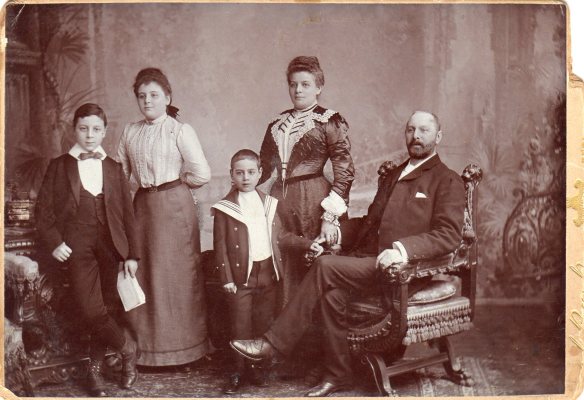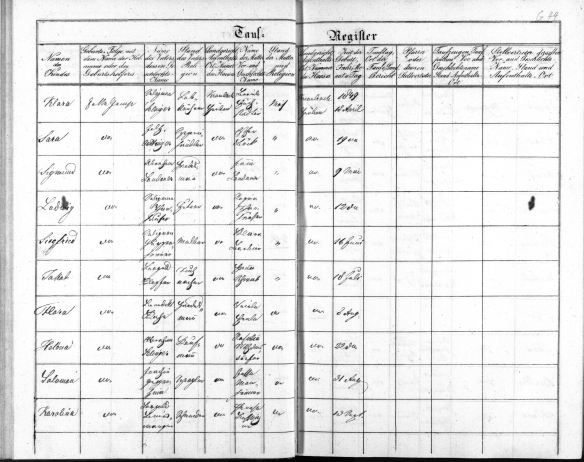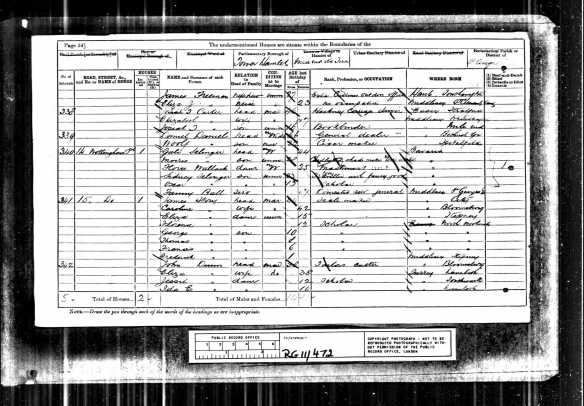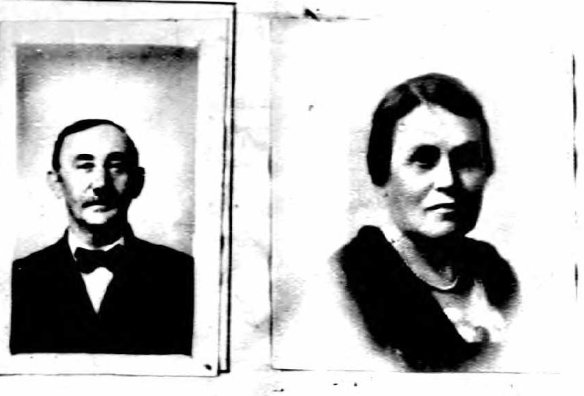In my recent post, I mentioned that I had been working with two other researchers on the mystery of the three Selinger men who married my Cohen cousins. Frederick Selinger had married my cousin Rachel Cohen in 1880 in Washington, DC. Rachel was the daughter of Moses Cohen, my three times great-uncle (brother of my great-great-grandfather Jacob). Julius Selinger had married Augusta Cohen in 1884 in Washington, DC; Augusta was the daughter of Moses Cohen, Jr. and niece of Rachel Cohen. Finally, Alfred Selinger had married Fannie Cohen in Washington, DC, in 1893. Fannie was also a daughter of Moses Cohen, Jr., also a niece of Rachel Cohen, and a sister of Augusta Cohen.
Way back on July 22, 2014, when I first posted about the three Selinger men, I had speculated that they all had to be related. Both Julius and Frederick had documents indicating that they had been born in Hurben, Germany. Alfred and Julius had lived together in DC before they’d married, and Alfred had traveled with Julius and Augusta to Europe before he married Augusta’s sister Fannie. But I had nothing to support that speculation besides that circumstantial evidence.
Then a month later on August 5, 2014, I wrote about the marriage of Eleanor Selinger to Henry Abbot. Eleanor was the daughter of Julius Selinger and Augusta Cohen; Henry was the son of Hyams Auerbach (Abbot) and Helena Selinger (some records say Ellen or Helen). I was curious as to whether Helena Selinger was somehow related to Julius and the other Selinger men, Alfred and Frederick. I thought that she might be since how else would an American woman have met an Englishman? And the shared name seemed too uncommon to be pure coincidence.
As I wrote then, I had contacted the owner of an Ancestry family tree who turned out to be Eleanor Selinger and Henry Abbot’s great-niece: Val Collinson. Val and I exchanged a lot of information, but we could not at that time find any definitive evidence linking Helena Selinger, her great-grandmother, to Frederick or Julius or Alfred. All were born in Germany, but it seemed from the records in different locations. Helena’s marriage record indicated that her father’s name was Abraham Selinger, whereas Julius had indicated on his passport application that his father was Sigmund Selinger. We were stumped. And that was that. Or so I thought.
Fast forward a full year to August, 2015, when I received a comment on my earlier blog post about Eleanor Selinger and Henry Abbot from someone named Shirley Allen, whose grandparents were Jacob Rosenthal and Fanny Selinger:

Fanny Selinger Rosenthal and her husband Jacob Rosenthal and their children Gladys, Daniel, and Alfred
Courtesy of Shirley Allen
I’ve been delving into my paternal (Rosenthal) family history. I’ve found that my grandfather Jacob Rosenthal was married to Fanny Selinger. Unfortunately I haven’t found anything further about Fanny other than she was born in Germany, probably in 1857. However, I’ve recently come upon a wonderful paper lace invitation to the 1873 wedding of Hyams Auerbach and Helena Selinger that you referred to. What I don’t know is why Fanny would have been invited. Clearly she and Helena were related – but how ?
Needless to say, I was intrigued. Maybe Fanny Selinger was related to Helena and/or maybe she was related to Julius, Frederick, and Alfred. Shirley and I communicated by email, and we both started digging.
I found a website called Jewish Genealogy of Bavarian Swabia (JGBS) that had records for Hurben and located 25 Selingers in their database, including those for Alfred and for Julius, who were the sons of Seligman Selinger and Breinle Hofstadter and thus were brothers, as I had suspected. Shirley and I both thought that Seligman Selinger had been Americanized to Sigmund by Julius on his passport application and that the birth records for Julius and Alfred confirmed that they were in fact brothers.
I also found a birth record for Helena Selinger, whose father was Abraham Selinger, not Seligman Selinger. Abraham and his wife Rosalia Wilhelmsdoerfer had six children listed: Seligman (1842), Raphael (1843), Pauline (1845), Karolina (1847), Heinrich (1848), and Helena (1849). Pauline, Karolina, and Heinrich had all died as young children, leaving Seligman, Raphael, and Helena as the surviving children of Abraham. Here is Helena’s birth record from Hurben in August 1849.

Helena Selinger birth record from Hurben (third from bottom)
http://jgbs.org/SuperSearch.php?Sp=3&Book=birth&Com=11
But what about Frederick? And Fanny? And was there a connection between Helena’s father Abraham and the father of Julius and Alfred, Seligman Selinger?
A little more digging on the JGBS site revealed that both Abraham Selinger and Seligman Selinger were the sons of Joachim Selinger, thus confirming that they were brothers and thus that Helena was a first cousin to Julius and Alfred.

Marriage record from Hurben for Abraham Selinger, son of Joachim, and Rosalia Wilhelmsdoerfer (second in page)
http://jgbs.org/detail.php?book=marriage&id=%206671&mode=

Seligmann Selinger, son of Joachim, marriage to Breinle Hoftsadter (second from bottom) 1848 http://jgbs.org/detail.php?book=marriage&id=%206695&mode=
That meant that Eleanor Selinger, daughter of Julius Selinger, had married her second cousin, Henry Abbot, son of Helena Selinger.
But that still left us wondering about Frederick Selinger and Shirley’s great-grandmother Fanny Selinger. How did they fit into this picture?
I contacted Ralph Bloch, the webmaster for the JGBS website, and he was extremely helpful. More helpful than I realized at the time, but more on that later. Ralph also could not find any evidence that Fanny was born in Hurben, and he reassured me that the birth records for Hurben were quite complete. He even searched through the original pages to be sure that Fanny hadn’t somehow been missed when the records were indexed. (There was a Fany Selinger born in the 1830s, but that would have been far too early for Shirley’s ancestor.) Ralph also sent a photograph of Seligman Selinger’s headstone, which confirmed that his father’s name was Joachim or Chaim, his Hebrew name.
So once again we hit the brick wall. We still had not found either Frederick or Fanny. Shirley said she would pursue it on her end, and I turned back to the other research I’d been doing when I received Shirley’s comment.
Not much happened again until late November when I heard again from Shirley, telling me that she had received a copy of Fanny Selinger’s marriage certificate, which revealed that Fanny was the daughter of Abraham Selinger. Now we could link Fanny to Helena, also the daughter of Abraham, as well as to Julius and Alfred, Abraham’s nephews. But we didn’t know if Fanny and Helena were both the daughters of Rosalia Wilhelmsdoerfer.
Shirley’s research of UK records showed that by 1871 Abraham was married to a woman named Gali, and we assumed that Abraham had left Hurben at some point, that his first wife Rosalia had died, and that he had had several children with Gali. That is what the UK census records from 1871 seemed to reflect. Abraham and Gali were living with Sigfried (28), Helena (20), Cornelia (18), and Oskar (4). But there was neither a Fanny nor a Frederick.
![Abraham Selinger and family 1881 UK census Class: RG10; Piece: 555; Folio: 86; Page: 3; GSU roll: 823397 Description Enumeration District : 10 Source Information Ancestry.com. 1871 England Census [database on-line]. Provo, UT, USA: Ancestry.com Operations Inc, 2004. Original data: Census Returns of England and Wales, 1871. Kew, Surrey, England: The National Archives of the UK (TNA): Public Record Office (PRO), 1871.](https://brotmanblog.com/wp-content/uploads/2016/02/abraham-selinger-and-family-1881-uk-census.jpg?w=584&h=341)
Abraham Selinger and family 1881 UK census
Class: RG10; Piece: 555; Folio: 86; Page: 3; GSU roll: 823397
Description
Enumeration District : 10
Source Information
Ancestry.com. 1871 England Census [database on-line]. Provo, UT, USA: Ancestry.com Operations Inc, 2004.
Original data: Census Returns of England and Wales, 1871. Kew, Surrey, England: The National Archives of the UK (TNA): Public Record Office (PRO), 1871.

Gali Selinger and family 1881 UK census
Class: RG11; Piece: 472; Folio: 118; Page: 55; GSU roll: 1341103
Description
Enumeration District : 9 Original data: Census Returns of England and Wales, 1881. Kew, Surrey, England: The National Archives of the UK (TNA): Public Record Office (PRO), 1881
I assumed that Morris, Flora, Sidney, and Oscar, all born after 1850, were born in a different place and perhaps to a different mother. Certainly Oskar had to be Gali’s child since he was so much younger than all the rest and only four on the 1871 census.
Searching again on Ancestry, I found a new record: an entry for Abraham, Rosalia, Seligman, and Raphael Selinger on the Mannheim, Germany, family register dated November 26, 1848. What were they doing in Mannheim? By that time the three younger children, Pauline, Karolina, and Heinrich, had died. Perhaps they needed a change of scenery. But what about Helena? She was born in Hurben in 1849.
Then I found a second Mannheim family register that included Helena, the final entry on the page:
![Abraham Selinger and family, Mannheim register Ancestry.com. Mannheim, Germany, Family Registers, 1760-1900 [database on-line]. Provo, UT, USA: Ancestry.com Operations, Inc., 2014. Original data: Polizeipräsidium Mannheim Familienbögen, 1800-1900. Digital images. Stadtarchiv Mannheim — Institut für Stadtgeschichte, Mannheim, Germany.](https://brotmanblog.com/wp-content/uploads/2016/02/abraham-selinger-and-family-1848-mannheim-register.jpg?w=584&h=910)
Abraham Selinger and family, Mannheim register
Ancestry.com. Mannheim, Germany, Family Registers, 1760-1900 [database on-line]. Provo, UT, USA: Ancestry.com Operations, Inc., 2014.
Original data: Polizeipräsidium Mannheim Familienbögen, 1800-1900. Digital images. Stadtarchiv Mannheim — Institut für Stadtgeschichte, Mannheim, Germany.
My friends in the German Genealogy group, Heike Keohane, Matthias Steinke, and Bradley Hernlem, came to my rescue and translated it to read, “Helene, his daughter, here born the 22 August 1849.” So Helena’s birth is entered on the Hurben birth records (on the same date) and on the Mannheim records. I’ve no idea which is the correct birthplace; maybe Rosalia went home to Hurben to give birth and returned to Mannheim afterwards where the family was living.
But perhaps now I could find out where Frederick was born, not to mention Morris, Flora, Sidney, and Oscar. Maybe they were born in Mannheim. I checked the Mannheim birth records from 1853 through 1866 and found not one person named Selinger. I checked over and over, looking at each page until my eyes were blurry. There were no Selingers born in Mannheim during that period that I could find.
Then I discovered that Oskar Selinger had listed Ansbach as his birth place on his UK naturalization papers and thought that perhaps the family had moved from Mannheim to Ansbach.

Oscar Selinger UK naturalization papers
The National Archives; Kew, Surrey, England; Duplicate Certificates of Naturalisation, Declarations of British Nationality, and Declarations of Alienage; Class: HO 334; Piece: 54
Description
Description : Piece 054: Certificate Numbers A20701 – A21000
I had no luck locating Ansbach birth records for that period, and by then it was Thanksgiving, and other matters distracted me, and I put the Selinger mystery on the back burner.
To be continued…..





I love reading about your mysteries!
LikeLiked by 1 person
Thank you! I love trying to solve them!!
LikeLiked by 1 person
This makes a fabulous read, linking Germany to the UK to the USA. So looking forward to the next part of the Selinger journey.
LikeLiked by 3 people
Thanks, Shirley! The journey wouldn’t have been nearly as much fun or as successful without you and Val!
LikeLiked by 1 person
Wonderful and oh so helpful information. Thank you so much 🙂
LikeLiked by 1 person
Thank you!
LikeLike
You’ve done it again Amy. Left me hanging and wondering….
LikeLiked by 1 person
LOL! I won’t make you wait too long. 🙂
LikeLiked by 1 person
I love that wedding invitation. What a delight. Well done, Amy. 🙂
LikeLiked by 1 person
I did also—so glad Shirley shared it with me. Thanks, Karen!
LikeLiked by 1 person
What a wonderful collaboration, and that invitation is just too cool. If it’s as delicate as it looks, it’s amazing that it survived.
LikeLiked by 1 person
I am going to ask Shirley, who has the invitation, how it was protected all these years.
LikeLiked by 1 person
And the gifts keep on rolling in! look at all the information coming your way. And that wedding invitation!!!!!!!!!!!! Oh my goodness, it’s so beautiful and fragile–how has it survived?
LikeLike
I love that invitation also. I will have to ask Shirley how it was preserved all these years. I’ve only seen her scan of it.
LikeLike
Pingback: Part II: The Benefits of Teamwork « Brotmanblog: A Family Journey
Some of you asked how the invitation survived all these years. I asked Shirley, and when she told me, its survival seemed even more remarkable. “It was tucked in between my Rosenthal photos in a tiny ripped envelope in an album. Damaged obviously, with a tea/coffee/ alcohol mark on, lots of the paper lace surround is missing. Cream card. I think just good luck how it survived, a quirk of fate. Am very glad it did.” I suggested she find a better way to preserve it for the future!
LikeLike
Pingback: England, Part IV: Visiting My Ancestors’ Neighborhood | Brotmanblog: A Family Journey